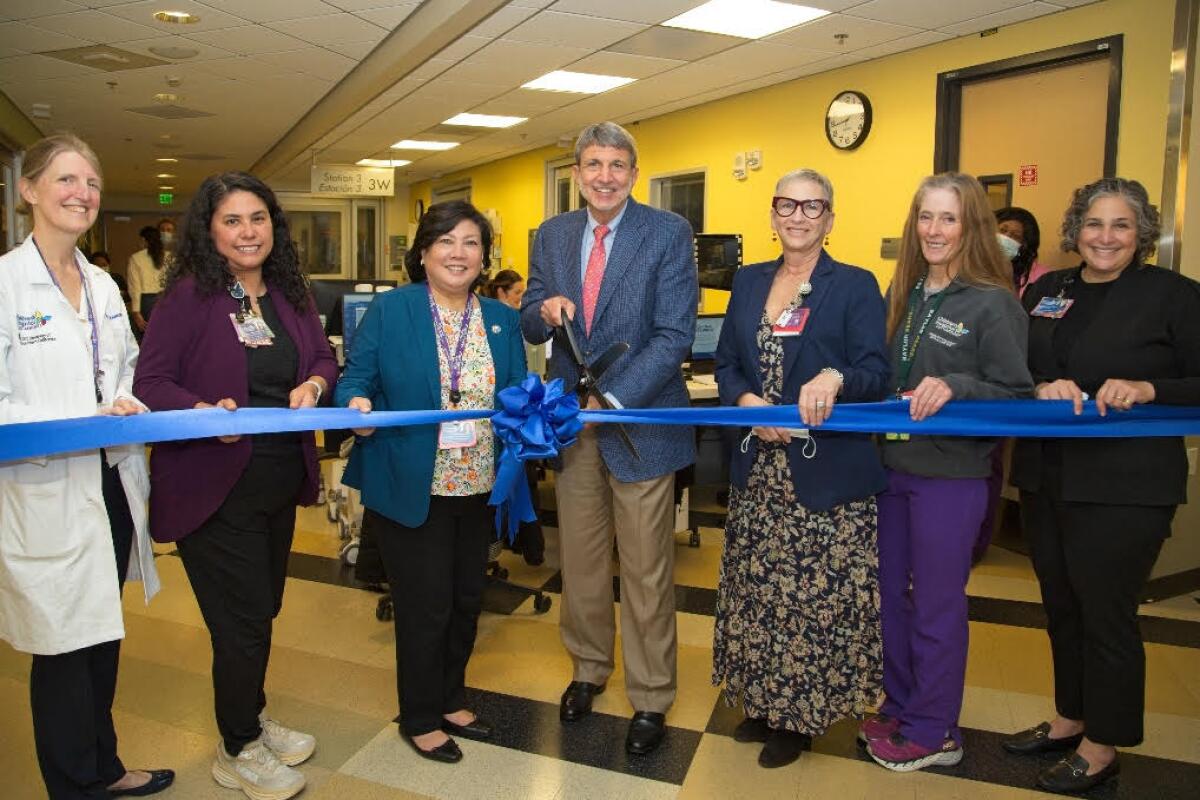Children’s Hospital Los Angeles Creates Dedicated Small Baby Unit to Care for Its Tiniest, Most Fragile Babies

- Share via
Hospital leaders mark the occasion with a ribbon-cutting ceremony recognizing the new program designed to meet the needs of babies born too early
Children’s Hospital Los Angeles (CHLA) has launched a dedicated Small Baby Unit to provide the highest level of specialized care to critically ill premature babies.
The program is located within the Steven & Alexandra Cohen Foundation Newborn and Infant Critical Care Unit (NICCU) and is supported by a specialized team of clinicians trained in the care of children born before 32 weeks.
“Low birthweight and extremely low birthweight babies need different care than term infants,” said Holly O’Quinn, DNP, a NICCU clinical nurse specialist at CHLA. Earlier this week, O’Quinn was joined by CHLA leaders and members of the hospital’s NICCU team to celebrate the launch of the 13-bed unit. “The Small Baby Unit allows us to optimize care for these little babies and give them the best chance for the best outcomes.”
As a Level IV NICCU, Children’s Hospital Los Angeles provides the highest level of care for the most critically ill babies. Although many of its patients are term infants, the Cohen Foundation NICCU also cares for babies born as young as 22 weeks, weighing just 400 to 500 grams (about 1 pound).
Additionally, CHLA’s neonatal care specialty is ranked the best among children’s hospitals in California and No. 6 in the country, according to the most recent U.S. News & World Report survey of Best Children’s Hospitals.
“The preterm and extremely preterm infants in our NICCU are typically critically ill, with issues beyond prematurity,” explained neonatologist Bridget DiPrisco, MD. “They come to us because they need complex, high-level care, such as surgeries or certain heart procedures.”
The Small Baby Unit groups all babies born before 32 weeks into one dedicated area of the NICCU. Patient rooms have been specially tailored for their needs with very dim lights and less noise and foot traffic.
“We chose an area where they can be a little more secluded, with less stimulation,” O’Quinn said. “The goal is to give them the best environment they can have outside of mom to grow and develop.”
Patients also receive care from dedicated nurses and therapists who have undergone special training in small baby care.
A multidisciplinary NICCU workgroup developed evidence-based guidelines to inform that training and improve standardized care. That group included neonatologists, nurses, respiratory therapists, occupational therapists and more.
Dr. DiPrisco and O’Quinn have helped to lead the efforts along with CHLA neonatologist Molly Easterlin, MD, MS. Dr. Easterlin participates in the Children’s Hospitals Neonatal Consortium (CHNC) Extremely Preterm Infant Focus Group, which aims to improve the care and outcomes of extremely preterm infants through national collaboration and research.
Care guidelines are based on research and cover such issues as:
- Reducing the risk of brain bleeds. Guidelines include the best positioning for the baby and the optimum rate for giving fluids and medications.
- Promoting lung health. Respiratory guidelines outline recommended pressure settings for ventilators with the goal of reducing the risk of chronic lung disease.
- Protecting delicate skin. Care teams follow detailed procedures to keep extremely fragile skin from breaking down.
- Ensuring proper positioning. Certain techniques can help prevent an extremely preterm baby from developing a flat head on one side, for example. The team also uses special wraps to keep babies’ hips and shoulders in alignment.
The Small Baby Unit also provides support to parents and families, who often spend months in the NICCU with their babies.
Through their specialized training, nurses direct the research-based Supporting and Enhancing NICCU Sensory Experiences (SENSE) caregiver education program, in which nurses coach parents and family members at the bedside on the level of stimulation their infant can handle week to week, based on gestational age. The program also celebrates milestones the infants reach, like receiving hand hugs from mom, hearing a song for the first time or having a story read to them by dad.
Hosted primarily virtually, it is also accessible to parents and family members unable to visit the unit via QR codes.
“It’s been incredible to see how happy and empowered the parents become through this program,” Dr. DiPrisco said. “It’s made a huge difference in their connection with their baby and what they can do for them.”